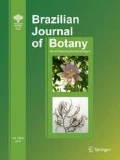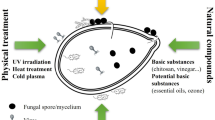Abstract
Extracts of garlic (Allium sativum L.) and neem (Azadirachta indica A. Juss.), BAU-Biofungicide (Trichoderma based preparation), Potent 250 EC (Propiconazole) and Bavistin DF (Carbendazim) were evaluated under laboratory and field conditions in controlling diseases of rice cv BR11 for quality seed production. BAU-Biofungicide (2%) showed significant effect in controlling mycelial growth of (Bipolaris oryzae (Breda de Haan) Shoem.), Cercospora oryzae I. Miyake, Rhizoctonia solani Kuhn. and Ustilaginoidea virens (Cke.) Tak. in-vitro test and also reduced disease severity of brown spot, narrow brown leaf spot, sheath blight and false smut as of Propiconazole (0.1%). Carbendazim (0.1%) showed better result in inhibiting the disease severity of narrow brown leaf spot and sheath blight. Propiconazole (0.1%) increased highest 26.40% grain yield, while BAU-Biofungicide (3%) increased 20.42% grain yield over untreated control in the field. Formation of maximum (74.33%) apparently healthy seed, highest germination (98.00%) increased 36.49% of vigor index by BAU-Biofungicide (2%) over control. Major seed borne fungi of harvested seeds were controlled by foliar application of BAU-Biofungicide.

Similar content being viewed by others
References
Agarwal PC, Mortensen CN, Mathur SB (1989) Seed-borne diseases and seed health testing of rice, chap 14. Technical Bulletin No. 3, Phytopathlogical Paper No. 30, CAB International Mycological Institute (CMI) Kew, Surrey, pp 58–59
Ahmad S, Mukesh S (2002) Evaluation of fungal and bacterial antagonists against Fusarium nioniiiforme causing foot rot disease of rice. Ann Agric Res 23:319–321.
Baki AA, Anderson JD (1973) Vigour determination of soybean seed by multiple criteria. Crop Sci 13:630–633
BBS (2014) Agriculture Wing, Bangladesh Bureau of Statistics. Ministry of Planning. Government of the People’s Republic of Bangladesh, Dhaka.
Biswas SK, Ratan V, Srivastava SSL, Ramesh S (2008) Influence of seed treatment with biocides and foliar spray with fungicides for management of Brown leaf spot and Sheath blight of paddy. Indian Phytopath 61:55–59
BRRI (1999) Some appropriate technologies of rice cultivation (Bengali Bulletin). Bangladesh Rice Research Institute, Gazipur
BRRI (2004) Modern rice cultivation. Bangladesh Rice Research Institute, Gazipur
Chen Y, Zhang Y, Yao J, Li YF, Yang X, Wang W-X, Zhang Gao AF (2013) Frequency distribution of sensitivity of Ustilaginoidea virens to four EBI fungicides, prochloraz, difenoconazole, propiconazole and tebuconazole, and their efficacy in controlling rice false smut in Anhui Province of China. Phytoparasitica 41:277–284
Chowdhury MMH (2012) Evaluation of quality status and management Truthfully Labeled Seed (TLS) of rice in Bangladesh, Ph.D. Thesis, Bangladesh Agricultural University, Mymensingh
Cumagun CJR (2012) Managing plant diseases and promoting sustainability and productivity with Trichoderma. J Agric Sci Technol 14:699–714
Dasgupta MK (1988) Principles of plant pathology. Applied Publisher Pvt Ltd., New Delhi
Elham K, Sadravi M, Naeimi S, Khosravi V (2011) Biological control of rice brown spot with native isolates of three Trichoderma. Braz J Microbiol 43:297–305
Fakir GA (2004) An annotated list of seed borne diseases in Bangladesh. Seed Pathology Centre, Department of Plant Pathology, Bangladesh Agricultural University, Mymensingh
Fakir GA, Mia MAT (2004) The quality of Farmer saved rice seeds in Bangladesh. National workshop on seed health improvement. BARC, Dhaka
Fattah GMA, Shabana YM, Ismail AE, Rashad YM (2007) Trichoderma harzianum: a biocontrol agent against Bipolaris oryzae. Mycopathologia 164:81–89
Gomez KA, Gomez AA (1984) Statistical procedures for agricultural research, 2nd edn. Wiley, New York
Groth D (2007) The Narrow brown leaf spot outbreak and its control in 2007. Rice Research Station, Crowley, LA
Gupta V, Shamas N, Razdan VK, Sharma BC, Sharma R, Kaur K, Chapal S, Johnand DJ, Kumar A (2013) Foliar application of fungicides for the management of brown spot disease in rice (Oryza sativa L.) caused by Bipolaris oryzae. Afr J Agric Res 8:3303–3309
Hasan MM, Chowdhury SP, Alam S, Hossain B, Alam MS (2005) Antifungal effect of plant extracts on seed-borne fungi of wheat seeds regarding seed germination, seedling health and vigour index. Pak J Bio Sci 8:1284–1289
Hasan MM, Islam MR, Hossain I, Shirin K (2014) Biological control of leaf spot of groundnut. J Biosci Agric Res 1:66–78
Hossain I (2011) BAU-Biofungicide: unique eco-friendly means and new dimension of plant disease control in Bangladesh. Leaflet published from the Dept. of Plant Pathology. Bangladesh Agricultural University, Mymensingh
Hossain M (2012) Biological control of leaf blight (Bipolaris Sorokiniana) of wheat. Ph.D. Thesis, Bangladesh Agricultural University, Mymensingh
Hossain I, Dey P, Hossain MZ (2011) Efficacy of Bion, Amistar and Tilt in controlling brown spot and narrow brown spot of rice cv BR11 (Mukta). J Bangladesh Agric Univ 9:201–204
IRRI (1996) Standard evaluation system of rice, 4th ed. International Rice Research Institute, P.O. Box 933,1099 Manila, Philippines
ISTA (1996) International rules for seed testing. Seed Sci Technol 4:3–49
Jat JG, Agalave HR (2013) Antagonistic properties of Trichoderma species against oilseed-borne fungi. Sci Res Rep 3:171–174
Kalaiselvi S, Panneerselvam A (2015) In-vitro evaluation of fungicides and two species of Trichoderma against Sarocladium oryzae causing sheath rot of paddy (Oryza sativa L). World J Pharmac Res 4:1200–1206
Kamal MM, Mia MAT (2009) Diversity and pathogenicity of the rice brown spot pathogen, bipolaris oryzae (breda de haan) shoem. In Bangladesh assessed by genetic fingerprint analysis. Bangladesh J Bot 38:119–125
Kumar KVK, Raju SK, Reddy MS, Kloepper JW, Lawrence KS, Groth DMME, Sudini H, Du BH (2009) Evaluation of commercially available PGPR for control of rice sheath blight caused Rhizoctonia solani. J Pure Appl Microbiol 3:485–488
Liao QM, Li HY (1994) Study advances of rice false smut in Yunnan province. Yunnan Agric Sci Technol 3:8–12
Liu MX, Oi S, Li Y, Wang S (2009) Study on isolation technique and culture condition of Ustilaginoidea virens. Liaoning Agric Sci 2:20–22
Mahmud H, Hossain I (2013) Eco-friendly management of brown spot (Bipolaris oryzae) of rice and quality seed production. In: 10th International Congress of Plant Pathology. The Chinese Society for Plant Pathology, p. 89
Mahmud H, Hossain I (2016) Effects of plant extracts, BAU-Biofungicide and fungicides on quality and health of seed. Bangladesh J Bot 45:677–684
Manimegalai V, Ambikapathy V, Panneerselvam A (2011) Biological control of paddy brown spot caused by Bipolaris Oryzae (Breda de Haan). Pelagia Research Library. Eur J Exp Biol 1:24–28
Mia MAT, Ahmad MU, Sharma NR, Ali A, Miah SA (1990) Antifungal activity of some plant extracts. Bangladesh J Bot 19:5–10
Naeimi S, Okhovvat SM, Javan-Nikkhah M, Vágvölgyi C, Khosravi V, Kredics L (2010) Biological control of Rhizoctonia solani AG1-1A, the causal agent of rice sheath blight with Trichoderma strains. Phytopathol Mediterr 49:287–300
Nene YL, Thaplial PN (1993) Fungicides in plant disease control. Oxford and IBH publishing Co. PVT. Ltd., New Delhi
Nisa TU, Wani AH, Bhat MY, Pala SA, Mir RA (2011) In-vitro inhibitory effect of fungicides and botanicals on mycelia growth and spore germination of Fusarium oxysporum. J Biopest 4:53–56
Ora NAN, Faruq MT, Islam N, Aktar Rahman MM (2011) Detection and identification of seed borne pathogens from some cultivated hybrid rice varieties in Bangladesh. Middle East J Sci Res 10:482–488
Patale SS, Mukadam DS (2011) Management of plant pathogenic fungi by using Trichoderma species. Biosci Dis 2:36–37
Razu MAU, Hossain I (2015) Eco-friendly management of rice diseases. Inter J Appl Sci Biotech 3:80–88
Sagar SD, Hegde YR, Kulkarni S, Rao MSL (2005) Biocontrol of seed mycoflora of rice. Ann Biol 21:217–220
Sundar AR, Das ND, Krishnaveni D (1995) In-vitro Antagonism of Trichoderma spp. against two fungal pathogens of Castor. Indian J Plant Protect 23:152–155
USDA (2016) World Agricultural Production. United States Department of Agriculture. Foreign Agricultural Services. Circular Series, WAP 12–16
Author information
Authors and Affiliations
Corresponding author
Rights and permissions
About this article
Cite this article
Mahmud, H., Hossain, I. Comparative efficacy of BAU-Biofungicide and synthetic fungicides in management of diseases of rice (Oryza sativa L.) for quality seed production. Braz. J. Bot 40, 389–397 (2017). https://doi.org/10.1007/s40415-017-0361-8
Received:
Accepted:
Published:
Issue Date:
DOI: https://doi.org/10.1007/s40415-017-0361-8




